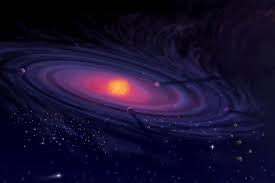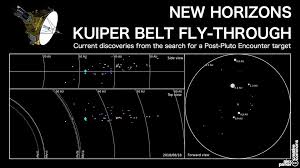Overview
The Kuiper Belt is located between the orbit of Neptune at 30 AU, or 30 times the distance of the Earth from the Sun, and 50 AU. It contains many icy objects, including dwarf planets Pluto, Haumea, and Makemake, and smaller planetoids. The New Horizons probe is scheduled to transmit pictures from that region of space in July 2015.
The Kuiper Belt
Almost as soon as Pluto was located in 1930, astronomers thought that many other objects orbited the Sun beyond Neptune. At that time, telescopes were not powerful enough to find other objects that far away. In the late 1980’s and 1990’s, some icy objects were found that were probably in that region of space. They are so small and faint that astronomers used special computer technology to scan photographs and find them.
Origin of the Kuiper Belt
The Kuiper Belt was formed about 4.6 billion years ago, as part of the formation of the Solar System. The part of the disc beyond Neptune was affected by the gravity of Neptune such that it remained in planetesimals rather than coalescing into a single large planet. Scientists first theorized that short-period comets first formed there, but later studies have suggested that the Kuiper Belt itself is too stable. Orbits of small objects within the Kuiper Belt tend to be more circular than those of comets.
Dwarf Planets
Many dwarf planets besides Pluto are within the Kuiper Belt. Many of them are called “plutinos”, and for every three orbits of Neptune, they orbit the Sun twice. The dwarf planet Haumea was found through observations in the early 21st century. It is also formed of icy rock and has at least 2 moons. The dwarf planet Makemake is about 2/3 the size of Pluto. It shows evidence of large amounts of methane and nitrogen ice. A large number of planetoids in the Kuiper Belt have been observed.
Exploration of the Kuiper Belt
Many of the early observations of Kuiper Belt objects have been made from large telescopes on Earth. Other discoveries by the Hubble Space Telescope have pinpointed the location of smaller planetoids. Those small objects are thought to be the building blocks of dwarf planets such as Pluto, and may hold important clues to the formation of the Solar System itself. Water ices within objects so cold and far away may hint at the way water was formed on planets closer to the Sun. In July 2015, the New Horizons mission will make its closest approach to Pluto, the largest body so far in the Kuiper Belt. The mission may be extended in 2016 to fly by some of these smaller objects that are billions of miles beyond Pluto.
Interested in science tutoring services? Learn more about how we are assisting thousands of students each academic year.
SchoolTutoring Academy is the premier educational services company for K-12 and college students. We offer tutoring programs for students in K-12, AP classes, and college. To learn more about how we help parents and students in Ithaca, NY: visit Tutoring in Ithaca, NY





